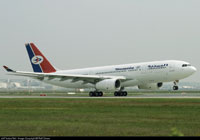
YEMENIA saw its passenger traffic increase 23 per cent last year, as the country’s tourism industry continued its steady recovery, according to a media report.
The airline carried 1.6 million passengers and earned $250 million in revenues last year, said Ameen Ahmad Al Haimy, assistant chairman of Yemenia, as quoted by the paper. In 2005, Yemenia reported 1.3 million passengers, with revenues of $213 million.
Preparing for future growth, Al Haimy also said Yemenia is in the midst of a modernisation programme in excess of $25 million, which included the purchase of revenue management and departure control systems from Emirates Airline.
The key for Yemen has been to facilitate the return of the country’s tourism industry, which was seriously derailed following the bombing of the USS Cole in 2000, followed by 9/11. The dropoff in traffic forced the airline to dramatically rethink its network route. “Today, the business is opening up, and tourism is coming back. Back then, tourism actually came to a halt,” he said.
Currently serving 35 cities with ten aircraft, Yemenia will take delivery of a Boeing 737-800 later this year.
Separately, the airline announced that it is to add two brand new Airbus 330-200 aircrafts to its fleet per an agreement signed with the International Lease Finance Corporation (ILFC). Both aircrafts will be received directly from the facilities of Airbus Industry in France during 2004.
“Yemenia is proceeding with such ambitious steps after having received the government’s blessing and support in recognition of its apparent achievements. His Excellency President Ali Abdullah Saleh gave directives to further strengthen the flag carrier enabling it to play a more efficient role in the country’s development plans in the years to follow,” Captain Abdulkhalek S Al-Kadi, chairman of Yemenia said in a Yemen Times report.
According to Yemenia sources, A 330-200 is ideally suited to the needs of the markets within medium and long range versatility to serve extended-range routes initially to South East Asia, the Near East and Europe regions. The new aircrafts will carry 283 passengers in first and economy classes offering more comfortable seats, and would have better payload carrying capabilities, and better range and take-off performance.
